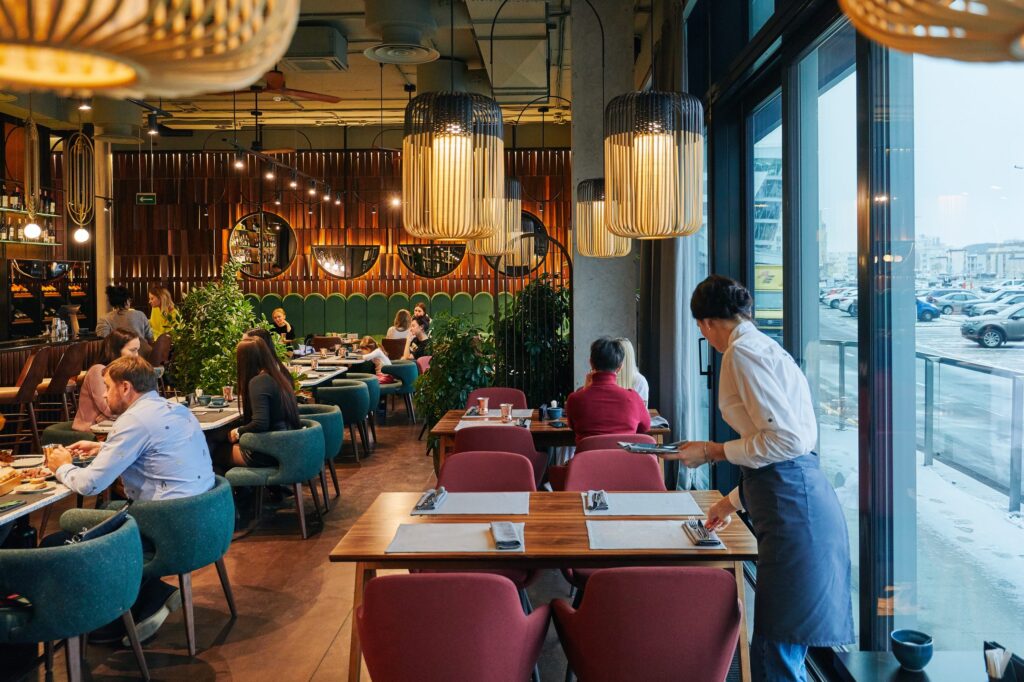How to grow restaurant business in the vibrant and diverse Indian market? is a question I, Nimra Khan, an expert in lead generation, often encounter. The key to thriving in India’s rapidly evolving food service sector lies in skilfully navigating its unique challenges and capitalizing on emerging opportunities. With my extensive experience in this field, I have observed that the ever-changing preferences of Indian consumers demand a strategic approach.
This approach must seamlessly integrate traditional business practices with modern, innovative strategies. Achieving success in a market as dynamic and multifaceted as India’s hinges on maintaining a delicate balance: it’s crucial to adapt to change while preserving the essence of traditional culinary experiences. This balance is not just beneficial; it’s essential for any restaurant looking to make a mark in this competitive landscape.
Table of Contents
ToggleUnderstanding the Indian Foodservice Market
India’s food service market is dynamic, characterized by a mix of traditional eateries, quick-service restaurants (QSRs), full-service restaurants (FSRs), and modern dining concepts. In 2022, the profit sector market size in India was a significant INR10.8 trillion, with projected growth at a CAGR of over 11% during 2022-2027. This growth is reflective of the increasing disposable incomes and the evolving tastes of Indian consumers, who are increasingly open to experimenting with new cuisines and dining experiences.
Key Steps to Grow Your Restaurant Business

In exploring how to grow restaurant business in India, it’s important to navigate through a series of procedural steps and secure a range of licenses in compliance with the country’s regulations.
- FSSAI License: Obtain a license from the Food Safety and Standards Authority of India (FSSAI), which is mandatory for any food business. The license type depends on the size, turnover, and other factors of your restaurant.
- GST Registration: Register your restaurant under GST and obtain a GSTIN Number. For restaurants operating in multiple states, separate registrations are required for each state.
- Professional Tax License: If you have salaried staff earning above Rs 10,000, a professional tax license is required, payable monthly.
- Liquor License: If you plan to serve alcohol, obtaining a liquor license is crucial and can be a complex and expensive process. It’s advisable to start this process early.
- Business Registration: Register your business as a partnership firm or a Pvt Ltd company. This involves filing annual returns and auditing your finances.
- Fire Safety Certificate and Pollution Control License: Ensure compliance with fire safety standards and pollution control norms. This includes obtaining a No Objection Certificate (NOC) from the fire department.
- Eating House License: Required for public restaurants where food and beverages are supplied for consumption. This involves obtaining a fire NOC if the seating capacity is more than 50 and providing site plans, photographs, and various other documents.
- Health/Trade License: Issued by the municipal corporation, this license is necessary for businesses that directly affect public health.
- Environmental Clearance License: For certain types of restaurants that might cause environmental pollution, clearance from the government is required.
- Shop and Establishment Act License: Register your restaurant under this act within 30 days of commencing your business. The cost varies based on several factors like location and number of employees.
- Lift License: If your restaurant has a lift, you need clearance that ensures the lift operations comply with safety norms.
For effective strategies on how to grow restaurant business, it’s important to recognize that each license involves distinct requirements, documents, and application processes that vary depending on the state or city. Make sure to organize all necessary documents and comply with the specific regulations applicable to your location.
To aid in how to grow restaurant business, seeking detailed information and guidance on each license from local authorities or legal experts is highly recommended.
To understand how to grow restaurant business, effective manpower management is key. This includes multiple essential steps, such as hiring the right talent, training them effectively, and retaining skilled staff. Here’s a step-by-step guide reflecting the latest industry insights:

- Recruitment: Start by asking for recommendations and checking references from previous employers to gauge the dedication and work history of potential candidates. Utilize different channels for hiring, such as referrals, social media, and staffing agencies. For part-time or seasonal staff, consider revisiting the previous year’s staff list or asking current employees for referrals.
- Training Program: Implement a comprehensive training program. This should start with preparing a staff training manual that acts as a guide for your restaurant staff. It should detail rules, processes, duties, and responsibilities. Conduct an orientation for new hires to make them familiar with the restaurant, its history, customer base, and management. The training should also focus on educating the staff about the restaurant’s operations and technologies used, like the POS system or mobile ordering app. Regular training sessions are crucial for keeping the staff updated and efficient.
- Cross-Training: Cross-training staff in various departments increases their efficiency and flexibility, enabling them to fill in for absent colleagues. This also fosters teamwork and ensures smooth business operations during staff shortages.
- Managing Shifts and Performance: Efficiently manage staff shifts, keeping in mind labour laws and the need for work-life balance. Regularly monitor staff performance using Key Performance Indicators (KPIs) to identify strengths and areas for improvement.
- Staff Management and Retention: Organize your workforce into different departments like kitchen staff, managerial staff, floor staff, bar staff, and delivery staff. Each department has specific roles and responsibilities. Implement incentive programs and rewards to engage and retain staff. Encourage professional development and offer training opportunities to increase staff loyalty and competence.
- Planning for Manpower: Before opening a restaurant, create a realistic labor schedule based on different levels of service and volume. Organize a job fair well in advance and hire more people than you think you’ll need, as attrition during the opening phase is common.
- Legal Compliance: Ensure compliance with local labor laws and regulations. This includes understanding minimum wage requirements, working hours limits, and health and safety regulations.
To learn how to grow restaurant business, implement these strategies for effective manpower management. This will result in a more efficient and productive team, essential for the prosperity of your restaurant.
To discover how to grow restaurant business, consider the critical steps involved in designing a stellar menu. This process is essential in crafting an appealing and profitable menu for your restaurant.

- Categorize Menu Items: Start by categorizing all your dishes into groups such as appetizers, entrees, and desserts. Prioritize items that are both popular and profitable at the top of each category for better visibility.
- Set Menu Prices: Pricing is critical and should be based on a deep analysis of food costs. Consider your current pricing structure, customer perception, and market trends to set appealing yet profitable prices. If you’ve had to increase prices for reasons like staff benefits, consider explaining this on the menu to connect with customers.
- Create Menu Descriptions: Write engaging and descriptive copy for each item. Use language that evokes taste and texture, and reflects the personality of your restaurant. Descriptive labels have been shown to increase sales and customer satisfaction.
- Decide on a Menu Color Scheme: Choose colours that reflect your restaurant’s brand and ambience. Think about how different colours can affect hunger and emotions.
- Design Your Restaurant Menu: Focus on a layout that is easy to read and navigate. Remember the “golden triangle” – customers typically look at the middle of the menu first, then move to the top right, followed by the top left. Place high-margin dishes in these areas. Ensure that the menu design aligns with your brand’s style.
- Use of Photos: Incorporating high-quality images of your dishes can boost their sales, but use them sparingly as too many pictures can give an impression of lower quality. Ideally, use images for your most popular or high-value items.
- Consider All Senses and Needs: Ensure your menu is accessible to all customers, including those with visual impairments. The menu should feel good to touch and be easy to handle.
- Stay True to Your Brand and Personality: Your menu should be a reflection of your restaurant’s unique identity. The choice of colors, fonts, and overall design should align with the concept and ethos of your establishment.
- Optimize Your Online Menu: Since many customers check menus online before visiting, ensure your menu is easily accessible and readable on your website and online ordering system.
- Menu Printing and Presentation: Decide on the physical size of your menu based on its layout, font size, and the number of items. Print enough menus for all customers, and choose quality materials that align with your restaurant’s style.
To learn how to grow restaurant business, consider focusing on your menu. It’s more than just a list of dishes; it’s a crucial component of your marketing strategy and customer experience. Regularly update your menu by taking into account customer feedback, incorporating seasonal ingredients, and analyzing sales data to ensure it remains fresh and enticing.
To understand how to grow restaurant business, it’s essential to recognize the importance of forging strong supplier relationships. Here’s a detailed guide on how to develop and maintain these vital partnerships for your restaurant’s success:

- Invest in Relationships: Treat your relationship with suppliers as a mutually beneficial partnership. Show that you are a reliable and trustworthy business partner. This can lead to better pricing, quality products, and positive referrals in the supplier network.
- Get Introduced: Leverage existing relationships to connect with other reputable suppliers. A good word from a current supplier can greatly help in establishing new connections.
- Request Product Samples: Before entering into a contract, ask for product samples. This helps in assessing the quality and suitability of the products for your restaurant.
- Conduct Thorough Research: Understand your restaurant’s specific needs and research suppliers accordingly. Visit local markets or farmer’s markets to connect with local producers, and consider joining a local food cooperative for bulk purchasing benefits.
- Socialize with Suppliers: Engage with suppliers on social media or through other channels. Share positive feedback about their products and services to strengthen the relationship and help them gain more business.
- Be Nice and Generous: Recommend your suppliers to others and include them in your decision-making process for new menu items. This shows them that they are valued partners in your business.
- Pay Suppliers on Time: Ensure timely payments to maintain trust and reliability. If there are potential payment delays, communicate openly with your suppliers.
- Go Local When Possible: Local suppliers can offer fresh, high-quality products and shorter shipping times. They can also be more responsive to your business needs due to proximity.
- Build Personal Relationships: Regularly communicate with suppliers beyond just placing orders or addressing issues. Personal interactions can significantly strengthen the partnership.
- Keep Suppliers Informed: Share any significant changes or developments in your restaurant with your suppliers. This helps them to adapt their services to your evolving needs.
- Provide Honest Feedback: Openly discuss any challenges or issues with your suppliers. This transparency can lead to quicker resolutions and improvements in products or services.
- Accurate Ordering: Keep a close track of your inventory and order accurately. This helps in effective planning and ensures timely delivery of products.
- Show Gratitude: Acknowledge and appreciate your suppliers for their service. Simple gestures of gratitude can solidify the relationship.
- Effective Supplier Relationship Management (SRM): Implement strategies like purchasing and paying for goods on time, collaborating on special items, measuring and analyzing supplier performance, and maintaining a beneficial two-way relationship.
Understanding how to grow restaurant business includes recognizing that strong supplier relationships are fundamental. These relationships are key to operational efficiency and can greatly influence your restaurant’s profitability and growth.
Revolutionize Marketing in Your Restaurant

Develop a Strong Brand Identity: Understand your target market and create a brand that appeals to their tastes and aspirations. Ensure consistency across all marketing materials, especially on social media, to reinforce your brand identity.
Utilize Guest Data for Personalized Marketing: Track customer preferences, visit frequency, and special occasions to create targeted and personalized marketing campaigns. This approach leads to higher success rates than generic marketing.
Implement SMS Marketing: Although SMS has a low click-through rate, it boasts a high open rate. Use SMS for direct offers like discounts or promotions tied to local events to drive traffic to your restaurant.
Showcase Your Ingredients: Highlight the quality and uniqueness of your ingredients. Use your website and social media to showcase the provenance of your food, which can attract customers interested in quality and special dining experiences.
Offer Online Delivery: Partner with popular food delivery apps to expand your customer base and tap into the convenience market. This can be a significant marketing win, as online delivery is extremely popular among consumers.
Engage Customers with Live Social Media Stories: Use formats like Instagram and Snapchat stories to share daily activities, and behind-the-scenes looks, and engage with customers in a more informal and personal way.
Focus on High-Quality Social Media Images: Food visuals are crucial, especially on platforms like Instagram. Invest in professional photography or learn to take appealing food pictures to make your dishes look irresistible online.
Leverage Local Suppliers: Partner with local suppliers for fresh ingredients. This not only improves food quality but also appeals to customers who prioritize local and sustainable dining options.
Create “Instagrammable” Dishes: Design dishes with a focus on presentation to make them visually appealing and shareable on social media. This can help in attracting a wider audience and generating buzz online.
Adapt Menu for Dietary Needs: Cater to various dietary preferences and allergies. This widens your customer base and ensures inclusivity, which is increasingly important among modern consumers.
Prioritize Exceptional Customer Service: Good service leads to positive reviews and word-of-mouth marketing. Train staff to provide excellent service, which can significantly boost your restaurant’s reputation.
Utilize Social Media Platforms Effectively: Be active across various social media platforms like TikTok, Twitter, and Facebook. Regular posting, engagement with followers, and leveraging the platforms’ features can significantly enhance your online visibility and brand presence.
Optimize Your Google Business Profile: Ensure your restaurant is listed on your Google Business Profile. Keep all information up-to-date, including contact details, menu, and hours of operation. Respond to reviews and engage with customers to improve your online presence and search ranking.
Have a Functional Online Menu: Ensure that your online menu is attractive, up-to-date, and easy to read. This is often the first thing customers look for on your website.
Implement Email Newsletters: Keep customers informed and engaged with regular email newsletters featuring new menu items, events, and special offers.
Create a Community on Your Facebook Business Page: Use your Facebook page to engage with customers, post updates, and encourage reviews. Keep your page lively and interactive to build a community around your brand.
Invest in Paid Advertising: Use paid ads on platforms like Google and Facebook to reach a wider audience. Target your ads geographically and demographically to ensure they reach your ideal customers.
In learning how to grow restaurant business, it’s crucial to follow these steps and persistently evaluate and adjust your strategies based on performance and customer feedback. This approach will help you build a robust marketing presence for your restaurant, attracting customers and nurturing loyalty and brand advocacy.
Mastering Soft Openings for Restaurant Growth”

Understand the Advantages and Disadvantages: A soft opening allows you to get feedback, iron out logistics, prepare staff, build anticipation, and make adjustments. However, be aware of potential drawbacks like creating urgency to open, exposing ideas to competitors, and receiving potentially low-quality feedback.
Send Invitations: Decide whether to send digital or physical invitations, and ensure they include all necessary event details such as date, time, address, pricing, RSVP method, and dress code.
Plan Timing and Capacity: Consider how many guests your restaurant can handle and possibly stagger guest arrival times for a manageable flow of service.
Build a Guest List: Include friends, family, local business owners, community leaders, and influencers. Each group brings different advantages, from providing constructive feedback to generating word-of-mouth advertising.
Decide on a Menu Strategy: You can opt for a full menu to provide a comprehensive overview, focus on signature dishes to highlight your restaurant’s specialities or target specific timespans with different offerings.
Determine Pricing: Choose between offering free food, a discounted menu, or limited full-priced options. Consider including complimentary selections to encourage guests to try a variety of menu items.
Create a Neighborhood Presence: Use the soft opening as an opportunity to integrate into the local community, perhaps by hosting additional events or participating in local food shows.
Collect Feedback: Gathering written feedback is crucial for making improvements before the grand opening. Consider providing feedback forms with the check and incentivizing completion with coupons or other offers.
Keep in mind, when exploring how to grow restaurant business, a soft opening is a critical step. It serves as a valuable opportunity to test and refine your restaurant’s operations and offerings before the grand opening.
Innovating Menus for Business Success

Research Market Trends: Start by researching current food trends and preferences in your target market.
Understand Local Tastes: Gain an understanding of local culinary preferences and cultural influences.
Brainstorm Unique Ideas: Brainstorm unique food ideas that can blend popular trends with local flavours.
Experiment and Develop: Experiment in the kitchen to develop these ideas into tangible dishes or products.
Test and Gather Feedback: Test these new offerings with a small group of customers and gather their feedback for improvements.
Refine Your Offerings: Refine the offerings based on feedback to ensure they meet customer expectations and preferences.
Marketing and Promotion: Once finalized, market these innovative offerings through various channels, highlighting their uniqueness and local relevance.
Monitor and Adapt: Continuously monitor customer responses and be prepared to adapt your offerings based on changing trends and preferences.
In the context of how to grow restaurant business, following these steps can help you successfully introduce innovative offerings. This approach aligns with local tastes and trends, thereby enhancing your restaurant’s appeal and competitiveness.
To effectively segment customers for a restaurant in India, follow these steps:
Choose a CRM: Invest in a CRM system that allows you to collect and manage customer data.
Tailor Your Restaurant’s Growth Strategy for Success

Identify Customer Personas: Analyze your customer data to identify common personas, like families, business diners, or young adults.
Segmentation Types: Utilize different segmentation types like geographic, demographic, behavioural, and psychographic. For instance, target families with kid-friendly menus and environments, or cater to business diners with quick, professional service.
Develop Targeted Marketing Plans: Create marketing strategies tailored to each segment. For example, use loyalty programs for regular customers and special offers for tourists.
Use or Build a Database Effectively: Integrate data from your POS and online ordering systems for comprehensive customer insights.
Make it Scalable: Automate your marketing processes using email platforms and segmentation automation tools.
Keep in mind, as part of learning how to grow restaurant business, that customer segmentation isn’t just about selling. It’s crucial for understanding customer needs and offering a dining experience that’s tailored to those needs.
Selecting Profitable Locations for Restaurant Growth

Understand Location Strategy: Location strategy is about determining where to locate your offices and employees. It should consider the cost, availability, and sustainability of labour, which is often the largest expense for a company. Analyze extensive market information and use labour data to make informed decisions.
Prioritize Target Geographies: Begin by creating a list of potential target locations. This involves customer, competitive, and market research to understand the size, growth, density, and needs of the customer base in those locations. Consider market size, maturity, dynamics, and competitive intensity. Utilize decision matrices and prioritization matrices to narrow down the options.
Assess Business Model in Target Geographies: Examine how your value proposition and go-to-market strategy will fare in each target geography. This step requires competitive benchmarking, market and regulatory research, and possibly consumer surveys. Also, assess the organizational and functional needs, investments, and costs to succeed in each chosen geography.
Score and Prioritize Target Geographies: Use an objective decision-making process involving decision matrices to score potential locations based on various criteria. This step involves ROI analysis, facilitated workshops, and business case analyses to determine the most valuable geographies for expansion.
Develop a Geographic Expansion Plan: Once you’ve determined your target geographies, create detailed plans for entering and growing in these locations. This includes aligning and involving functional and geo owners who will drive the expansion’s success and assessing potential partners or acquisitions that could facilitate scaling in the new geographies.
Consider Long-Term Implications and Sustainability: Your location strategy should be far-ranging and accommodate expansion plans. Think about whether there’s potential for real estate expansion in the chosen location, even if it may be years down the road.
Analyze Key Metrics and Data-Driven Site Selection: Use data to guide the real estate selection for your business. Site selection criteria should include location, size, real estate costs, market potential, safety, competition, the potential for future expansion, neighbourhood reputation, zoning, visibility, and available infrastructure.
Think About Customers, Employees, and Suppliers: Consider the impact of the location on your customers, employees, and suppliers. This includes accessibility, safety, cost implications, and convenience. For example, businesses that rely heavily on foot traffic should be in easily accessible and safe areas.
In understanding how to grow restaurant business, it’s vital to follow these steps to strategically select locations. This approach will boost visibility and footfall, contributing to the successful expansion of your business.
Tech-Savvy Menus & Healthy Trends

Introduce Personalized Menus: Utilize AI-powered platforms like THE.FIT to create customized menus for each guest based on their individual dietary preferences. This technology allows restaurants to quickly adapt to various dietary needs and preferences, improving customer experience and potentially increasing revenue. THE.FIT, for instance, uses a simple QR code that guests can scan to select their dietary preferences and view a personalized menu.
Embrace Healthy Food Trends: With the growing demand for healthy food, particularly among millennials, it’s important to adapt your menu. This includes offering dishes made with healthy ingredients like millet and catering to lifestyle diseases and traditional preferences. Restaurants have successfully increased their sales by focusing on healthy food trends, employing tactics like influencer marketing to promote their brand and aesthetically pleasing food presentations.
Utilize Advanced Restaurant Technologies: Implementing the right technology can significantly enhance your restaurant’s efficiency and customer satisfaction. Consider integrating various types of technologies, such as:
Touchscreen Point of Sale (POS) Terminals: For efficient order-taking and processing.
Order and Pay at the Table: To improve safety, speed, and efficiency, especially important post-COVID-19.
Handheld Point of Sale Systems: For at-the-table ordering and payment, enhancing customer service and operational speed.
Contactless Payments: To provide safe and secure payment options for your customers.
Self-Order Kiosks: For quick service and fast casual dining experiences.
Implement Menu Engineering and Management Software: Use restaurant management software to help design your menu effectively, standardize recipes, and manage raw material costs. This not only aids in adding healthy and nutritious dishes but also helps in reducing food costs. Innovative menu engineering using the same ingredients in multiple dishes can also be beneficial.
Focus on Aesthetic Food Presentation: Make your dishes and restaurant space visually appealing. Good lighting, greenery in dishes, and themed presentations can attract customers and cater to healthy food trends. Additionally, running healthy food marketing campaigns and contests related to a healthy lifestyle can further enhance your brand.
Implementing these steps is key in learning how to grow restaurant business. It allows you to effectively adapt to new dietary preferences and technology trends in the industry. This adaptation caters to a broader range of customer needs and preferences, while also enhancing operational efficiency.
Conclusion
In conclusion, the secret to how to grow restaurant business in India lies in a thorough grasp of local market dynamics, culinary preferences, and the ability to adapt to evolving trends. Success hinges on an emphasis on quality, innovation, exceptional customer service, and targeted marketing. This focus is key for restaurateurs to tap into the extensive opportunities presented by India’s vibrant food service market.
Consult with an expert and Get a Free Digital Marketing Strategy for your brand.







